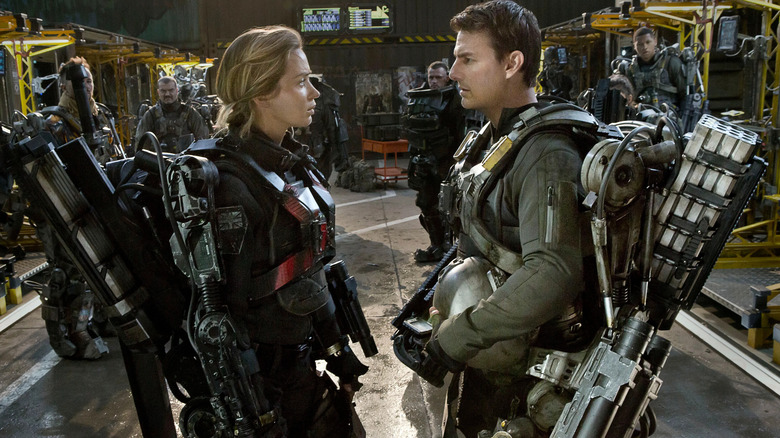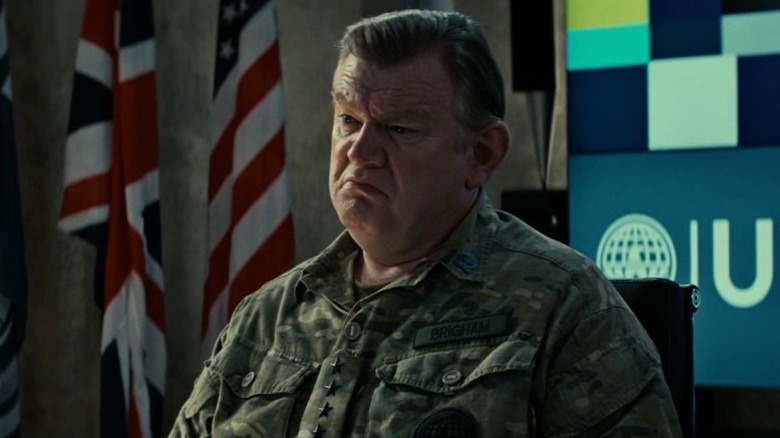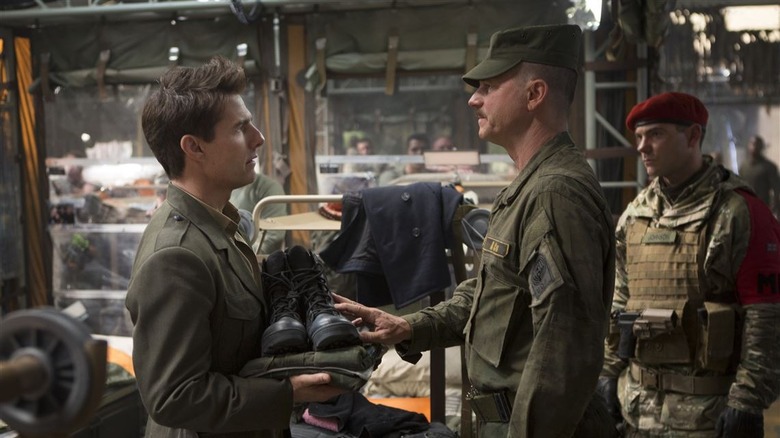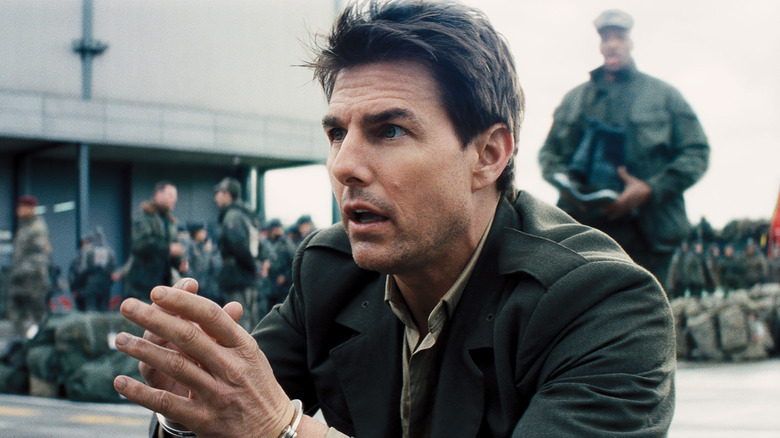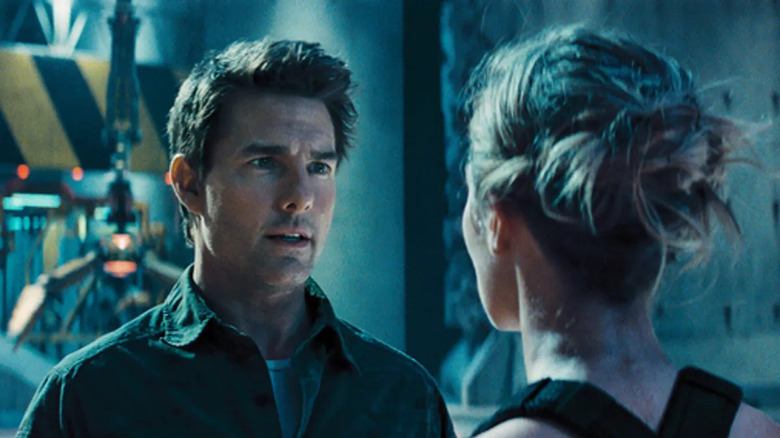Dumb Things In Edge Of Tomorrow Everyone Just Ignored
Long after a young Tom Cruise learned how to fly fighter planes in "Top Gun," and long before an older Tom Cruise taught pilots how to fly in "Top Gun: Maverick," a Tom Cruise just starting to show his age caused trouble for the military in 2014's "Edge of Tomorrow." Though it earned a positive reception from critics and audiences, "Edge of Tomorrow" didn't quite conquer the box office. Still, this unapologetically traditional summer blockbuster is remembered fondly today.
"Edge of Tomorrow" combines two popular tropes from sci-fi and action movies — aliens and time loops — with two movie stars who excel in the genre: Cruise, who plays Major William Cage, and Emily Blunt, who plays Sergeant Rita Vrataski. Watching these two fight and flirt while decked out in mech-suits and covered in alien goo is a straight-up blast. However, those viewers capable of turning off their brains and enjoying the show might be able to have a little more fun than viewers who can't. "Edge of Tomorrow" has a clever-sounding sci-fi premise, but in practice, this popcorn-y humans-versus-aliens flick is light on science and heavy on fiction. These are the dumbest things in "Edge of Tomorrow" everyone simply ignores.
Producers never really settled on a title
Before we get into the eyebrow-raising goings-on within "Edge of Tomorrow," we should address the eyebrow-raising decision-making that went into its marketing. The film is based on Hiroshi Sakurazaka's 2004 sci-fi light novel "All You Need Is Kill." It took awhile for the big screen adaptation to get off the ground, but when Cruise signed on in December 2011 (per Variety), the project was officially on its way.
A little more than two years later, the first footage aired at San Diego Comic-Con under a different title: "Edge of Tomorrow." Title swaps aren't that uncommon, especially after projects are screened for focus groups. But Warner Bros. and director Doug Liman disagreed on what to call the film from the beginning. Liman told Den of Geek that he and the studio both wanted an update to the original title, but Warner Bros. wanted to call it "Edge of Tomorrow," while he liked the cheekier "Live Die Repeat." Liman felt his title better communicated the plot and tone of the film he was making, but the studio got its way. When the expensive "Edge of Tomorrow" disappointed at the box office, he lobbied executives to switch to "Live Die Repeat" mid-run. Today, posters, DVD and Blu-ray cases, and digital copies can be found bearing all three titles, though "Live Die Repeat: Edge of Tomorrow" is the most common.
Life post-invasion is far too normal
Most of "Edge of Tomorrow" takes place in an alternate 2020, five years after aliens called Mimics crash-land onto the Earth via asteroid. The Mimics first make contact in Germany and quickly begin to assert their dominance over Europe. Humanity fights a losing battle against these electrified, tentacled aliens from this point forward ... or so we're told by an opening montage of news reels. But the ferocity of the Mimics and the current stalemate they seem to be locked in with humans doesn't really add up.
While we're informed that whole cities and nations have been lost to the invaders and soldiers sent to the front lines have good reason to be terrified, everyday life seems to be more or less intact for a sizable percentage of the population. There's TV, most infrastructure is still in place, utilities are available, and the food supply doesn't appear to have run out. The world's leaders and militaries even seem to be cooperating. Sure, we're losing, but it's hard to believe that in five whole years spent fighting a superior and relentless hive mind, people haven't outright lost. The mech-suits are a major help, but realistically, the Mimics probably should've made short work of humanity long before we got around to perfecting them.
The mech-suits hinder more than they help
The mech-suits look cool enough in still photography (particularly as sported by Rita in the propaganda seen on buses and buildings), but once their human operators start to move in them, it becomes painfully obvious how clunky they are. They make walking into a chore, their controls are tricky to figure out, and they require external batteries, which seem fairly short-lived. All of this puts the wearer at serious risk, should their speed be reduced or their power fail.
But the most ridiculous thing about the mech-suits is that they offer little protection to vulnerable body parts. Most of the torso and all of the limbs are exposed. Moreover, they don't seem to provide enough structural support to safely encase a human body from a crushing injury or a fall. This is curious, since the soldiers who wear them are dropped out of planes. They're not without benefits, of course: The mechs can be outfitted with multiple weapons, and the user can fire those weapons with limited recoil. But is that a worthwhile tradeoff for walking around in heavy metal stilts? Their mass also appears to be inconsistent throughout the movie. At one point, Cage and Rita manage to fit into a regular car wearing mech-suits that dwarf their bodies on the battlefield. The real purpose of these contraptions is more aesthetic than practical in nature.
Major Cage tries to talk his way out of combat
Major William Cage underwent a slight rewrite after Tom Cruise came on board, according to The Los Angeles Times. Cage went from being a generic soldier stuck in a time loop against the aliens to a man of a certain age who's never seen combat and never intends to. As he pitches to General Brigham (Brendan Gleeson) when he's enlisted to actually fight, he hopes to get by on his charisma and ability to recruit new warriors to the cause.
The idea of a high-ranking military official fearing and even trying to get out of service is interesting and novel. For the first few beats of the scene between Cage and Brigham, Cage's tactics are even sort of reasonable. However, when Brigham puts his foot down and tells Cage that his participation in the upcoming operation is a command and not a request, the Major tries to politely decline several more times. Once he realizes he's being arrested for attempted desertion, he tries to make a run for it and is easily subdued. This serves as the beginning of his time loop. That Cage thinks he can simply turn down orders to fight a war for humanity's very existence shows just how irreverent Liman wanted his movie to be.
J Squad doesn't recognize Cage from TV
After Cage fails miserably in his misguided attempt to avoid the battlefield, he's sent to a prep zone under the watchful eye of Master Sergeant Farell (Bill Paxton). Brigham has demoted Cage to private and labeled him a deserter; Farell, in turn, assigns him to J Squad and tasks the soldiers under his command with readying him for action. The scene in which Cage first meets J Squad is one of the bits that plays out over and over again, with minor but accumulating changes to the order of events and Cage's knowledge of his fellow recruits.
The troops in J Squad are depicted as cartoonishly rough-and-tumble. They don't take kindly to having to train Private Cage, who they notice is wearing an officer's uniform. While this is all a bit cliché, it's in keeping with the plot and character development. What stretches believability is that the members of J Squad don't recognize Cage from the news. Sure, there might not be TVs at makeshift military bases in the apocalyptic future. But in the prior scene, Cage claims he's basically the spokesperson for the armed forces, responsible for inspiring millions to serve. This is a small plot hole and a missed opportunity. J Squad could've had much more fun ragging on the new guy if they knew who he was.
The training bots are unnecessarily deadly
Cage first meets Rita during the central fight against the Mimics. After a few more encounters and resets, she tells him to find her. The next time he dies, he takes her up on the offer and locates her at a training facility. She's practicing her moves within what seems like the most dangerous gymnastics studio the world has ever seen. Large, sharp, fast-moving bots whirl around the space, which Rita easily (and Cage barely) avoids. Convincing her that he's stuck in a time loop goes well, though. It turns out, Rita was also either blessed or cursed with an inability to die, which is how she became the "Angel of Verdun." But her help comes at a high price.
Rita spends a considerable number of days (and Cage's lives) working with him in her off-limits gym. Each time he suffers an injury — say, a broken limb or back — she kills him so they can try again tomorrow. It's reasonable that she puts Cage out of his misery, but it's unreasonable that the mechanical Mimic simulators are so lethal in the first place. Not only are they wasting whole chunks of days every time Cage makes a mistake (and testing the limits of his ability to reset time), Rita's also putting herself at unnecessary risk, since she's lost her gift. This is yet another part of the worldbuilding in "Edge of Tomorrow" that looks hardcore but isn't practical.
The time resets don't really make sense
Time travel and time loop movies live and die by how well they explain their science — or lack thereof. Sometimes, less is more: "Groundhog Day" and "Palm Springs" are great examples. Other times, the means and butterfly effects become the star of the show (see: "Back to the Future"). "Edge of Tomorrow" ranks high in terms of entertainment value, but somewhere in the middle as far as its time loop conceits are concerned.
The Omega, we're told, manipulates time as a defense mechanism. Whenever an Alpha is killed, a reset is triggered. The Omega mistakenly recognizes Cage, with his accidental Alpha blood transfusion, as one of its own, and winds back the clock each time he perishes, with no butterfly effect to speak of. That's actually a pretty elegant rationale for a time loop ... so far. Things begin to fall apart when we prod further. It seems like the Omega can actively control time, while Cage is a passive recipient. When the Mimics are victorious after the initial battle, why doesn't the Omega just choose not to reset? And why does it reset to an exact but random moment (Cage coming to at the base) instead of the start of the previous day, or 24 hours prior to each death? What happens if Cage lives more than 24 hours? Would the reset change? The particulars feel like contrivances and excuses to replay certain scenes.
Rita's lost power is suspect
Rita warns Cage that if he tells anybody else about his newfound ability, he'll probably get sent to a psychiatric ward. It's implied that this is what happened to her after she killed an Alpha, was exposed to its secretions, woke up the day after her death, and told her superiors about it. The only person who believed her was her friend, Dr. Carter (Noah Taylor), an underground scientist who studies the Mimics. Even though they're no longer conscious of the accumulating resets and have to start each day meeting Cage from scratch, they devise systems to keep track of the information they glean together.
That information includes two key pieces of advice that Rita passes onto Cage. The longer he has Alpha blood in his system, the more he'll start to experience visions of the Omega. They want to exploit this power to hunt the Omega down and destroy it. Just as importantly, he cannot be wounded and survive. Rita tells Cage that she lost the power to reset after she received a blood transfusion following the Mimics' apparent defeat at Verdun. This plot point adds high stakes to "Edge of Tomorrow," which can feel a bit weightlessly video game-y, but it's not something Rita could know for sure. She only feels like she can't reset; she hasn't actually died again and tested out the theory ... at least, not in the days between Verdun and meeting Cage.
Cage and Rita repeat stupid mistakes
Rita does die occasionally within Cage's time loop, but since there's no butterfly effect and nothing's permanent, he finds her in the same place and position every day, just as he finds himself. First, Cage uses his apparent immortality to escape. We see him practice rolling under moving vehicles until he gets it right. He also uses it to gather intel on his fellow soldiers and wield more power within J Squad. Cage and Rita harness the blank slate that is the reset to try different tactics, in the hopes of either winning the battle in France or finding and killing the Omega. For the most part, Cage learns from his mistakes and makes progress.
However, there are points along the way where Cage makes a choice that he should already know results in a loss. For example, in one scene that amps up the romantic tension, Cage and Rita run out of gas and wind up at a farm house. He reveals they've been here before. If that's true, he should've remembered to take or find extra fuel. Why would he bring her to the same spot over and over again, where he knows Mimics are lurking and Rita is likely to die in the helicopter? Moreover, in one reset, he chooses not to confide in and involve her, as he'd have to realize she'd die on the battlefield in France, as happened when they first crossed paths.
They use the transponder at the worst possible time
The logic of "Edge of Tomorrow" unravels as the movie barrels toward its conclusion. Dr. Carter has invented a prototype of a device that he hopes can ping the whereabouts of the Omega. For it to work (and he's never sure it will), its prongs have to be stabbed into the body of an Alpha. Rita realizes that they can try Carter's transponder on Cage, who has Alpha blood. The only problem is, the United Defense Force and Brigham have possession of it, and the famous and wanted Cage and Rita will be captured if they show their faces at headquarters.
After multiple attempts to get into Brigham's office, Cage and Rita finally pull off their heist. Then, they make the stupidest decision in the movie's runtime. The smart move would be to stick Cage in the leg right then and there, discover the Omega's hiding spot, and dispatch Cage so that the day and mission begin anew. They only have to break in; with Cage's power intact, they never actually have to break out. But the duo tries to make a run for it, for absolutely no good reason. They use the transponder in the middle of a car chase, which does supply them with the location of the Omega (the Louvre), but also results in a horrific crash. Cage and Rita are taken into custody, and the former is given a life-saving blood transfusion. This presumably robs him of the chance to wake up again the next time he dies. It's a significant blow to their odds against the Mimics.
The happy ending breaks the movie's own rules
"Edge of Tomorrow" is full of slightly under-baked plot and character developments that exist to serve the action-packed spectacle. This isn't an unforgivable sin. But when "Edge of Tomorrow" reaches its ending, it just stops trying. Cage and Rita (and the world at large) get a happy ending that completely breaks the movie's own rules about time travel.
In the final attack on the Omega, Rita is killed, and a newly able-to-die-for-real Cage uses his last breaths to bomb the hive mind. Then, he wakes up — not at the base camp as a private, but on his way to Brigham's office in his old capacity. The humans have prevailed and everybody we've met along the way is perfectly fine. That even goes for Rita, who happens to be back in her familiar yoga pose on the floor, the way Cage has "met" her probably dozens, if not hundreds, of times before.
None of this checks out. The resets are the Omega's defense mechanism. Either Cage defeats it and time keeps moving on (meaning he and Rita die, but the humans win), or it's back again the next (well, the same) day. Plus, since there's no butterfly effect, a reset should mean everything else is the same, too. It makes no sense that the rest of existence and Cage's day plays out differently this time, but Rita's proceeds exactly as before.



